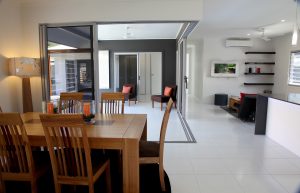System Overview
Gem Link® Wireless consists of three main components:
- Passive Infrared (PIR) Occupancy Sensor
- Wireless Entry Door Switch
- Transceiver Control Module connected to the HVAC system
HVAC (Heating and Air Conditioning) Control
- Detection of Occupant
When guests open the entry door, a signal is transmitted to the Transceiver Module that the door has been opened. A second signal is transmitted when the door is closed. The Passive Infrared (PIR) Occupancy Sensor detects the presence of guests via infrared body heat and transmits this event to the Transceiver Module. GEM Link® Wireless immediately releases control of the HVAC thermostat to the guest who then sets the temperature at their desired level.
- Locked in Occupied Mode
Once control of the HVAC is released, GEM Link® Wireless “locks” the system into the Occupied Mode, after the Entry Door is closed. No further detection of the guest is required. The guest may take an extended bath, sleep with covers over their head, or sit very still reading a book and the HVAC system continues to operate under normal guest control day or night.
- Opening Patio/Balcony Door
If a patio/balcony door is opened, a Door Switch Module transmits this event to the Transceiver. GEM Link® Wireless will turn off the HVAC unit after a programmable Time Delay selected during installation. For example, with a Time Delay of 30 seconds, the guest could open the patio/balcony door, step outside, close the door behind them, and there will be no interruption to the HVAC operation.
However, if the patio/balcony door is left open longer than the programmed Time Delay, the Transceiver Control Module will turn off the HVAC and prevent operation as long as the patio/balcony door remains open. This prevents hot humid air from condensing on cool surfaces and reduces the chance of mold and mildew. The HVAC unit will not operate with the patio/balcony door open longer than the programmed Time Delay.
- Leaving the Guestroom
When the entry door is opened, it resets the Transceiver Control Module from the Occupied Mode to a Time Delay mode. If the entry door is then closed and guests remain in the room, the PIR Sensor detects guests still present via infra-red body heat and the GEM Link® system again locks into an Occupied Mode. However, if all guests have left the room and the PIR sensor does not detect guest presence, the Transceiver Control Module continues in the Time Delay Mode and will turn off the HVAC unit after the selected programmable Time Delay. This is normally set at 10-20 minutes.
- Temperature Setback
The Transceiver Control Module monitors room temperature during unoccupied periods and will release the HVAC unit when room temperature reaches the selected Setback Temperature. The air conditioning will operate to reduce the temperature two degrees below the selected Setback Temperature and then turn off again. This prevents the guestroom from becoming too hot in the summer or too cold in the winter when unoccupied.
The Setback Temperature is programmable by time and tempeature in one-degree increments. The HVAC unit is not allowed to operate continuously in physically unoccupied guestrooms. GEM Link® Wireless maintains the suite at an energy conserving Setback Temperature pre-selected by management. The System is programmable in four (4) Levels of Setback, each by time and temperature, for gradual setback over a period of time.
Control of other Electric Appliances
To reduce high-energy consumption of other electric appliances, a second Transceiver Module is wirelessly “Slaved” to the Master HVAC Transceiver Control Module. The Master Transceiver Control Module communicates with the Slave Transceiver to indicate when the guestroom, suite, or conference room is occupied or unoccupied. The Slave Transceiver controls many other electric appliances, such as electric cook tops, water heaters, or even lighting systems while sharing the same PIR Sensors and Door Switches.
This describes basic GEM Link® Wireless energy management operation for controlling HVAC and other electric appliances.


